 |
 |
|
 |
Speech language pathologist on tap to improve communication skills |
 |
 |
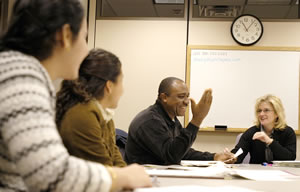 |
|
Civil engineering students Ranjani Dasiga, Traffic; Maria Lobo, Bridge, and Samuel Tweh, Metro District Design, meet with Stacey Helstrom, a speech language pathologist on contract with Mn/DOT. Photo by David Gonzalez |
What do a snowplow operator radioing a dispatcher, a Seeds student preparing for an interview for the graduate engineer program and an engineer making a presentation have in common?
These Mn/DOT employees may be among a growing number of employees who do not have English as their first language, said Lynnette Geschwind, affirmative action officer. For these employees, a strong accent may mean that how they communicate stands in the way of what they communicate.
Accent modification with a speech pathologist and cross-cultural communication training can help, according to Stacey Helstrom, a speech language pathologist on contract with Mn/DOT. The department recently hired Helstrom’s company, SpeechPros Consulting, to help address communication challenges that arise when employees with different accents try to talk to each other or with the public.
“The purpose of the contract is not to teach English grammar or composition skills,” Geschwind said. “Many of these employees have advanced degrees and their command of English is exceptional—especially considering English might be their second, third or even fourth language. But a strong accent makes it difficult to be understood, especially by someone with little or no exposure to non-native speakers,” she said.
Helping Seeds students prepare for the future
Students in the Seeds program are among the first Mn/DOT employees to make use of the service.
Emma Corrie, Seeds program manager, said that many Seeds employees are preparing to enter Mn/DOT’s graduate engineer program. As part of the application process students must go through a formal interview. To prepare for the interview, and for the expanded duties they will face if they enter the program, six students are meeting as a pilot group with Helstrom.
“The goal is not to lose our diversity—to make everyone the same—but rather to make sure their knowledge is being fully communicated and appreciated,” Corrie said.
“Learning to modify a strong accent can be an important contribution to their careers and give them a terrific boost of confidence. They already have the academic credentials to succeed,” she said.
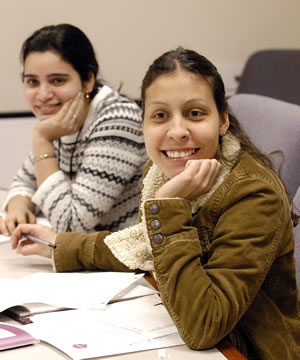 |
Ranjani Dasiga and Maria Lobo are among the first Mn/DOT employees to make use of the accent modification and cross-cultural training service. Photo by David Gonzalez |
Improving team communication
Helstrom also assists work units to improve team communication when different accents and cultures are involved. Cross-cultural communication training is another way to improve understanding.
She is currently working with a Mn/DOT group whose members represent and provide service to at least four different heritages. Using speech therapy techniques and cross-cultural communications training, she is helping them to more effectively exchange information.
“It isn’t just about teaching the non-native speakers how to modify their accents,” she said. “Everyone on the team is also benefiting from coaching that teaches listening skills that allow them to focus on what is being said and not on the accent.
“For example,” Helstom said, “speech therapy can help the employee master English pronunciation, and just as importantly, can also attune co-workers to common language-specific differences in pronunciation so that they can better understand what their co-worker is saying.”
Helstrom’s services can also help English-as-a-first-language employees understand and communicate better with the public, Geschwind notes.
“Strong accents can be an even bigger problem for employees who communicate over the phone or by radio,” Helstrom said. “An employee with a strong accent may be understood fairly well when they are talking face-to-face with someone. But when you lose all the visual cues you have in face-to-face conversation, it may be much harder to make yourself understood.
“In another example, Americans are typically offended by people who do not make eye contact with them when they are speaking,” Helstom said. “Yet, looking away while speaking is a sign of respect in some cultures. Once team members understand these differences, they can begin to work together more constructively.”
Bringing value to Mn/DOT
“Mn/DOT’s Diversity Council enthusiastically supports Helstrom’s work with Mn/DOT,” said Geschwind. Funding is provided by the affirmative action office.
“It changes lives,” Helstrom said of accent modification. “Many of my clients are on their way up in an organization, and new job duties are putting them in positions where they are making presentations or supervising others. They feel that their accent may stop them from being as successful as they otherwise might be.
"By giving employees the tools they need to be successful and loyal, an employer addresses a huge factor in retaining a highly qualified employee who might otherwise leave an organization.”
It also saves money.
For example, Helstrom said, an employee who makes $80,000 a year and spends 30 minutes a day struggling to be understood can cost an organization $5,000 a year in lost time. Factor in one co-worker spending 20 minutes a day on clarifying communication with the employee and lost time expenses can approach $8,000 a year.
Employees who feel that they would benefit from improving their speaking or listening skills can contact Helstrom to set up an appointment.
Helstrom typically meets with an employee for assessment to determine what approach to take—what can make the biggest difference in the shortest amount of time. After that she meets with an employee individually or in a group of four to six participants for 10 sessions.
There is no charge to individuals or their offices.
For more information contact Helstrom at Stacey@speechpros.com or visit her Web site at www.speechpros.com.
By Kay Korsgaard
Toastmasters can ease speaking jitters
Toastmasters is an international organization that can help people from all backgrounds learn to effectively speak, conduct a meeting, lead, delegate and motivate.
Members practice their speaking skills at weekly meetings and learn by speaking to groups and working with others in a supportive environment.
In the Central Office, Capitol Toastmasters meets in room G-14, every Tuesday from noon to 1 p.m. Visitors are always welcome. For more information, contact Maude Wortham, Cindy Bellefeuille or Erling Hallanger.
To find a meeting near you, check out the Toastmasters International Web site at: http://www.toastmasters.org/find/results.asp?AREA=usa&NAME=MINNESOTA.
|
|
back

|
 |
New legal section supports rule-making, regulatory functions |
 |
 |
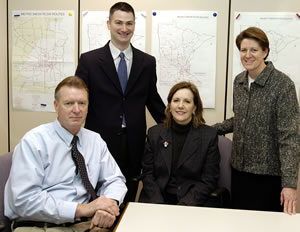 |
|
Rules and Transportation Regulations Proceedings Section staff include (from left) Jan Lahtonen, Sergius Phillips, Deb Ledvina and Laura Nehl-Trueman. Photo by David Gonzalez |
Mn/DOT’s Rules and Transportation Regulation Proceedings Section now offers services such as rule-making assistance and legal information to all department divisions, offices and districts.
The RTRP section was previously part of the Office of Freight and Commercial Vehicle Operations in Mendota Heights where its staff focused on legal matters related to motor carrier and rail issues.
The section is now part of the Office of Business and Support Services in St. Paul.
The section supports additional department functions such as workers' compensation administration and prevailing wage enforcement for contractors, said Deb Ledvina, section manager.
“By being located in the Central Office and within OBSS, our services are more available at the department level,” she said. “We can provide rule-making services, administrative hearing assistance and legal review and guidance for a number of policy and department initiatives. We can help ensure that department standards and procedures are legally sound and ensure due process so that agency decisions are not arbitrary or capricious.”
Section legal staff, Ledvina said, may support contested case hearings and other administrative procedures such as those related to workers’ compensation cases, the establishment of railroad crossings, the location of billboards and the pre-qualification of consultants. Staff, she said, can provide legal background, review and analyze an issue, work with the deputy commissioner in making an agency decision, and communicate decisions about the case to the parties involved.
The section’s staff, she said, also works with the experts in technical areas such as aeronautics, state aid and transit providers to adopt any standards or procedures they use into formal administrative rules.
The staff includes Ledvina, attorneys Sergius Phillips and Laura Nehl-Trueman; Jan Lahtonen, workers’ compensation coordinator, and Linda Tobritzhofer, workers’ compensation payroll coordinator.
Mn/DOT and other agencies, she said, are authorized by the Legislature to write administrative rules for policies and procedures that have general applicability and future effect on the public and customers they serve. The RTRP Section ensures that this authority is used whenever practicable and necessary.
“Our official legal representation rests with the Attorney General's office,” said Mike Garza, Business and Support Services director, “but the section plays an essential support role that can help us take a more consistent approach to issues that require legal interpretation, support or action.”
For more information about Mn/DOT statutes, rules and transportation regulation proceedings, go to http://www.dot.state.mn.us/information/rules.html.
By Craig Wilkins
|
back

|
 |
Emergency management function joins homeland security function |
 |
 |
With the addition Dec. 1 of the department’s emergency management activities, Mn/DOT’s Homeland Security and Emergency Management function is ready for business.
According to Sonia Pitt, homeland security director, Mn/DOT's homeland security function was created a year ago to bring a greater focus on security and emergency response to Mn/DOT operations and activities.
“We will work at developing Mn/DOT’s ability to respond to emergencies, as well as on other homeland security needs,” she said.
HSEM staff includes:
- Bob Vasek, who has been involved with Mn/DOT’s role in the state emergency management center for a number of years. He will work with evacuation planning for the Twin Cities metro area and will continue to work with the state Emergency Operations Center. Vasek will also train Mn/DOT employees to work at the EOC during training exercises and actual activations.
- Jody Gunlock, who has a strong background in planning and military operations. He will work on risk and threat assessments for all Mn/DOT critical infrastructure and facilities. He will also develop a plan for defining and handling security-sensitive information.
- Ernest Lloyd, who will assess and develop Homeland Security and Emergency Management training needs for Mn/DOT employees. Types of training will include the National Incident Management System, the Highway Watch program and suspicious materials handling classes. Lloyd will also work with Gunlock in conducting the risk and threat assessments.
The office has already completed its first major effort in assessing Mn/DOT’s emergency response systems. It ran an exercise in October at Camp Ripley that evaluated the agency’s ability to respond to a series of emergency events. (See Oct. 20, 2004 Mn/DOT Newsline.)
The exercise identified Mn/DOT emergency response strengths and areas where the agency could improve.
“Overall, we did a very good job, considering the environment we were in and the fact that we had pulled in people from all over the state,” Pitt said. “Our maintenance operations did very well, as did the fictitious ‘District 19’ management.
“In the next year, the HSEM office will develop and provide the training to build up our planning and communications efforts,” she said. “And we will examine equipment needs as well, to make sure we have what we need to respond when there is a problem.”
By Kevin Gutknecht
|
back

|
 |
Larsen named new federal relations manager |
 |
 |
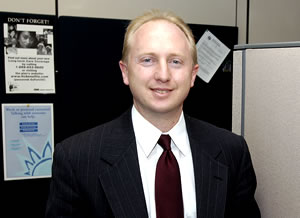 |
|
Brad Larsen is Mn/DOT's new federal relations manager. Photo by David Gonzalez |
Brad Larsen has been named Mn/DOT’s new federal relations manager, announced Betsy Parker, Office of Government Affairs director. His appointment is effective Dec. 15.
In his new role, Larsen is Mn/DOT's principal contact with the members of Minnesota's congressional delegation and their staffs. His major responsibilities also include liaison on transportation issues with Gov. Tim Pawlenty's office in Washington, D.C., and coordination and communication of Mn/DOT's positions on reauthorization of the six-year federal transportation funding bill.
Larsen has worked for Mn/DOT since 1996 in the Office of Investment Management and has extensive experience with the development and implementation of state and federal transportation funding laws and related policy issues. He had major roles in implementing the state transportation revolving loan fund and the governor's bond accelerated project program. He has both a law degree and a master’s degree in public administration.
Larsen’s new office is Room 456, Transportation Building , Mail Stop 140. He can be reached at 651/282-2170 or brad.larsen@dot.state.mn.us.
|
back

|
 |
Pilots honored for safe flying records |
 |
 |
 |
|
Recipients of MBAA awards left to right: are pilots Tim Valento, who accepted the award for Ken Patz (now retired); Jack Lynch and Rick Braunig. Photo by Dan McDowell |
Three Office of Aeronautics pilots received recognition Dec. 14 for completing milestones of safe flying hours in Minnesota. Combined, Mn/DOT’s six pilots have flown more than 51,000 hours of accident-free flying hours.
Lt. Gov./Commissioner Carol Molnau presented the Minnesota Business Aircraft Association Safety Awards to Jack Lynch for 12,000 hours of safe flying and to Rick Braunig for 1,500 hours. Tim Valento, Mn/DOT’s chief pilot, accepted the award for Ken Patz (now retired) for 3,500 hours of safe flying.
“I want to personally thank Mn/DOT pilots for getting passengers safely to meetings and appointments throughout the year,” said Molnau. “Their services are vital to the operation of important state work.”
Molnau further recognized Braunig, a captain and helicopter pilot in the Naval Reserve, who will be deployed to Iraq next year.
Molnau commended the Office of Aeronautics, which will be recognized in 2005 for 29 years (19,000 business flight hours) of safe flying.
“The Office of Aeronautics has provided excellent service to the state of Minnesota and demonstrated the value of aviation to all Minnesotans,” she said.
The Office of Aeronautics operates Minnesota's fleet aircraft, including a King Air C-90 and a King Air B-200, and two Beech Bonanza A36 aircraft.
By Donna Lindberg
|
back

|
 |
Asphalt awards recognize quality, innovation |
 |
 |
Awards for the year’s best plant-mix paving projects based on pavement rideability, joint quality, appearance, complexity and design compliance were presented last week to nine Mn/DOT employees and others at the 51st Annual Asphalt Conference.
Lt. Gov./Commissioner Carol Molnau presented the 2004 Asphalt Paving Awards to Mn/DOT, local government, contractor and consultant participants at the conference, which was held in Brooklyn Park.
“These awards recognize individuals and teams that have proven success in maintaining quality standards, while also adhering to contract requirements,” Molnau said. “They also emphasize the importance of partnerships between the asphalt industry, government agencies and road builders and designers.”
The theme of the conference was “Paving the way the right way.” Conference sessions provided information about new products and innovative ways to produce roadway surfaces that cost less and last longer.
Deputy Commissioner Doug Differt made opening remarks at the conference.
“Mn/DOT and local governments are looking at ways to improve pavement performance and shorten project times with innovative products and techniques,” Differt said.
“Pavement awards are no small accomplishment in Minnesota, where we experience extreme climate variables and rapidly increasing travel demand,” Molnau said. “They also address Mn/DOT priority objectives for roadway safety and preservation.”
Mn/DOT employees receiving 2004 Asphalt Pavement Merit Awards were Don Stanley, Bud Lehti, Dave Mavec and Todd Davidson, Duluth/District 1; Kevin Adolfs, Bill Johnson and Isaac Saarberg, Virginia/District 1; Dale Feda and Trent Mechels, Metro District, Golden Valley.
Award winners were determined by a rating panel that included representatives from Mn/DOT and the Minnesota Asphalt Pavement Association.
By Donna Lindberg
|
back

|
 |
Fast-acting neighbor, family dog, rescue retiree Ben Crandall from canoe mishap |
 |
 |
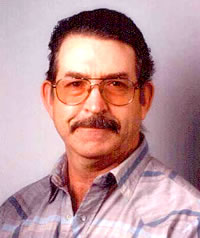 |
|
Ben Crandall |
District 3 retiree Ben Crandall’s dog, Buddy, is a friend indeed. Buddy played a prominent role in Crandall’s rescue on Dec. 8 when he fell into the icy water of Little Mud Lake near St. Michael while hunting geese.
Crandall went into the water after he tried to retrieve a bird from his canoe that landed on the ice. A lifejacket kept him afloat, but his repeated attempts to climb onto solid ice failed because his heavy jacket, including pockets crammed with shotgun shells, caught on the ice.
Fortunately, Steve Bragg, an observant and quick-thinking neighbor, saw the mishap as he prepared to start hunting. Bragg grabbed a rope and fastened it around the collar of Crandall’s dog, Buddy. Then he urged the dog, a one-year-old Labrador , to venture out on the thin ice near shore and take the line to Crandall.
The strategy worked.
Crandall called out to Buddy, snagged the rope with a pole, and tied the line around his waist. Bragg, joined by his spouse, Nila, and a volunteer firefighter, pulled Crandall to closer to shore. He was then able to swim and eventually wade to safety.
Although out of immediate danger, Crandall was not completely out of trouble. A few hours after his rescue, he began having symptoms of hypothermia and was hospitalized briefly.
Fully recovered the next day, Crandall resumed hunting once again.
Crandall retired last year as the maintenance supervisor at Elk River in District 3, capping a 36-year career with Mn/DOT.
“I am really fortunate and blessed by the Lord because Steve had not planned to go hunting that night, but changed his mind at the last minute,” he said.
By Craig Wilkins
|
back

|
 |
|
 |



